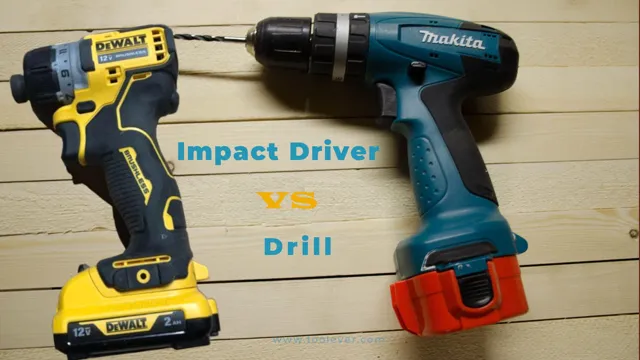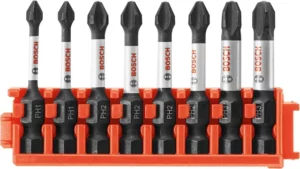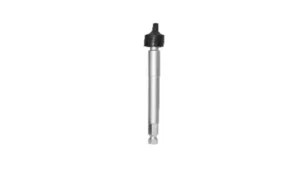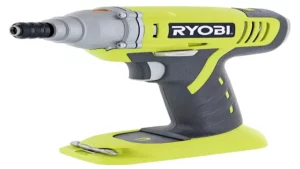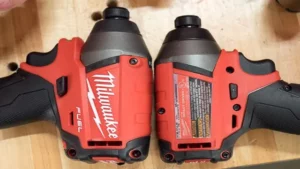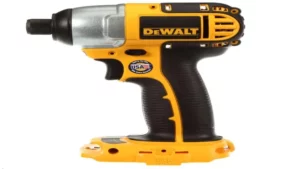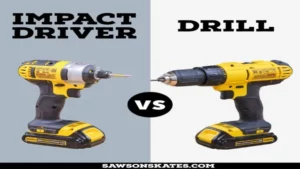When it comes to DIY projects or household repairs, having the right tools can mean the difference between a job well done and a complete disaster. Two of the most common power tools used in such situations are the drill and the impact driver. They both have different strengths and weaknesses and are frequently used together.
But the question remains, do you need both a drill and an impact driver in your toolkit? Let’s explore the differences and find out which one is right for you.
Understanding the Purpose of a Drill and an Impact Driver
“Do you need both a drill and an impact driver for your DIY project? The answer depends on the task at hand. A drill is best for making holes in wood, steel, or concrete, or driving screws and bolts into these materials. It has a clutch that can be adjusted for precise torque settings, which is ideal when working with delicate materials.
An impact driver, on the other hand, is designed for tasks that require high torque and fast action, like drilling into hard surfaces or working with lag bolts. It uses a rotational force called impact to drive the fastener and can make quick work of tough projects. While both tools can accomplish many tasks, it’s important to consider their strengths and weaknesses before deciding which one to use.
However, if you’re a serious DIYer, having both in your toolbox can make a world of difference and give you the flexibility to tackle any job that comes your way.”
Drill: For Making Holes
When it comes to DIY projects, having the right tools is essential. Two tools that often get confused but serve different purposes are a drill and impact driver. A drill is typically used for making holes in materials like wood, metal or plastic, while an impact driver is used for driving screws, bolts, and nuts into these materials.
A drill usually has a chuck that can hold twist drill bits that are used for making holes. The motor rotates the bit at high speeds, which creates the hole. It’s important to choose the right drill bit for the material you’re working with and to use the correct speed.
On the other hand, an impact driver has a hexagonal chuck that holds bits or sockets. It uses a combination of impact and rotation to drive screws with more force and speed than a regular drill. Impact drivers are usually more powerful whereas drills are more versatile.
Understanding the difference between these two tools will help you use them more efficiently and achieve better results.
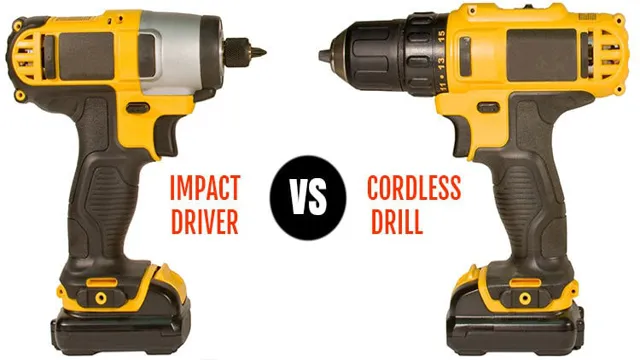
Impact Driver: For Driving Screws and Bolts
An impact driver is a powerful tool that is specifically designed for driving screws and bolts. While a drill is also capable of drilling holes and driving screws, an impact driver’s purpose is to provide a burst of rotational power to drive larger and longer screws that require greater force. The key difference between a drill and an impact driver is the way they deliver that force.
A drill applies a steady torque, while an impact driver delivers bursts of rotational force with each turn of the bit. This makes it easier to drive screws into hard materials like concrete or dense wood, and reduces the likelihood of stripping the screw head. If you are looking for a tool to handle heavy-duty screw and bolt driving tasks, an impact driver may be the best choice.
With its better torque output and powerful performance, it can make short work of even the toughest jobs.
Factors to Consider
Are you embarking on a DIY project and wondering if you need a drill and an impact driver? The answer depends on your specific needs and the nature of your project. If you’re working with softer materials like drywall or wood, a drill may suffice. However, if you’re dealing with tougher materials like concrete or masonry, an impact driver can deliver more force and get the job done faster.
Additionally, if you’re working in tight spaces or need to drive screws precisely, an impact driver’s compact size and variable speed settings may be preferable. Ultimately, it’s wise to consider the materials you’ll be working with, the level of precision required, and the amount of force needed before making your tool selection. So, do you need a drill and an impact driver? It ultimately depends on your specific project needs and goals.
Project Requirements
When starting a new project, there are various factors that one needs to consider to ensure that the outcome meets the requirements. The first factor to consider is the client’s needs. Understanding what the client wants and expects from the project is essential in creating a product that meets their expectations.
Another factor to consider is the scope of the project. This involves identifying the goals and objectives of the project and setting priorities to ensure that the most important tasks are completed first. Project timelines and budgets should also be established to ensure that the project is completed within the required timeframe and budget.
Additionally, the technical requirements of the project should also be considered. This entails understanding the technology required to execute the project and ensuring that the necessary resources are available to implement it. By taking into account these factors, one can ensure that the project meets the client’s needs, is completed within the required timeline and budget, and meets the technical requirements.
Budget
When it comes to budgeting, there are several factors that you must take into consideration. Creating a budget is not just about keeping track of your expenses and income. Other elements such as your financial goals, your lifestyle, and unexpected expenditures also play a huge role in determining your budget.
Additionally, it is essential to understand your cash flow. You need to know when your incomes stream in, and when your bills are due. This knowledge will give you an awareness of where your money is coming from and where it is going.
Finally, it’s important to be realistic about your expenses and income. This means that you need to be honest about your spending habits and income streams. By doing so, it will be much easier to create a budget that you can stick to without feeling overwhelmed or stressed.
Remember, a budget is a tool to help you achieve your financial goals, so be sure to take the time to create one that works best for you.
Frequency of Use
When it comes to deciding how often you should use a particular product or service, there are a few factors you should consider. The first is simply the nature of the product or service itself. For example, some things are meant to be used every day (like toothpaste) while others are meant to be used only occasionally (like a hot air balloon ride).
Another factor to consider is your own personal habits and preferences. Are you the type of person who likes to use things regularly or do you tend to forget about them? Additionally, you should think about the cost and convenience of using the product or service. If it’s expensive or time-consuming to use, you may not want to use it as often.
Overall, the frequency of use will depend on a variety of factors, but by considering these key factors, you can make an informed decision about how often to use a particular product or service.
Pros and Cons of Owning a Drill and an Impact Driver
If you’re someone who enjoys DIY projects or needs to complete household repairs, it’s worth considering whether you need a drill and an impact driver. Both tools have their pros and cons. A drill is versatile and can be used for a range of tasks, including drilling holes and driving screws.
It’s relatively easy to handle and can be used for long periods without causing too much fatigue. An impact driver, on the other hand, is ideal for driving long screws or bolts into tough materials like hardwood or metal. It can also be used for drilling, but it’s not quite as versatile as a drill.
The downside to owning both tools is that it can be expensive. If you’re on a budget, you may need to think carefully about which tool would be most useful for your needs. However, if you can afford both tools, they make a great combination for tackling a range of DIY projects.
Additionally, owning both tools means you won’t have to switch between different bits as often, which can save you time and hassle. In conclusion, whether you need a drill and an impact driver depends on the type of projects you’re planning to tackle. If you’re planning on doing a lot of drilling and driving, owning both tools can be useful.
However, if you’re on a tight budget or only need one tool, consider the pros and cons carefully before making a decision. Overall, both tools have their strengths and weaknesses, so it’s up to you to decide which one best suits your needs.
Pros of Owning Both
If you’re looking to do some serious DIY projects around your home, owning both a drill and an impact driver is a must. The pros of having both of these tools in your arsenal are endless. Firstly, drills are great for making holes in wood, metal, or concrete, while impact drivers are specifically built to drive screws and bolts with ease.
Owning both can help you tackle a wide range of tasks with precision and efficiency. Secondly, drills are great for smaller jobs while an impact driver is perfect for larger ones. Using the right tool for the job can ultimately save you time and effort, ensuring a professional finish.
Lastly, owning both can mean the difference between a job well done and a job done poorly. With the right tool at your disposal, you can get the job done with ease and confidence, and with less risk of damaging your materials. So, if you’re serious about DIY, owning both a drill and an impact driver is a must.
Cons of Owning Both
Owning both a drill and an impact driver can have its pros and cons. On one hand, it provides the owner with a versatile range of power tools to take on a variety of tasks. However, it can also lead to clutter in the workspace and added expenses.
It’s essential to consider whether the investment is worth it as both tools have different purposes. Drills are best suited for creating holes or driving screws, while impact drivers provide more torque for heavy-duty tasks like attaching metal fasteners. However, if you’re a DIY enthusiast or a professional, owning both can save time and effort while increasing efficiency.
It’s crucial to analyze your specific needs and determine whether the advantages outweigh the disadvantages before making a decision.
Conclusion
In essence, the question of whether you need a drill and an impact driver is similar to the question of whether you need both a fork and a spoon. Sure, you could make do with just one or the other, but having both tools in your arsenal will make your life a whole lot easier. So, if you’re serious about DIY or construction work, it’s worth investing in both a drill and an impact driver to handle all your needs like a pro.
“
FAQs
What is the difference between a drill and an impact driver?
A drill is used for drilling holes while an impact driver is used for driving screws.
Can I use an impact driver as a drill?
No, an impact driver is not recommended for drilling as it applies a high amount of torque which can damage the drill bits.
Can I use a drill bit in an impact driver?
Yes, you can use a drill bit in an impact driver with a hex shank, but it is not recommended for heavy-duty drilling.
What type of project requires a drill and an impact driver?
A project that involves drilling and driving screws into wood, metal or concrete would require both a drill and an impact driver.
Should I buy a drill and impact driver combo kit or separate tools?
It depends on your needs and budget. A combo kit is usually more cost-effective, but separate tools offer more versatility.
How much torque do I need for an impact driver?
It depends on the type of project. For light-duty projects, 1000-1200 in-lbs of torque is sufficient. However, for heavy-duty projects, you may need up to 2000 in-lbs of torque.
Can I use an impact driver for automotive work?
Yes, an impact driver is commonly used for automotive work as it can easily remove and install lug nuts. However, you may need different types of accessories for different tasks.
